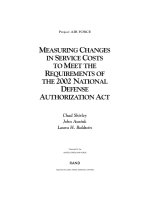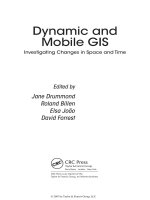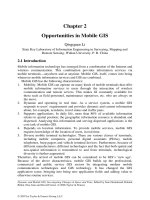Main changes in incoterms 2020
Bạn đang xem bản rút gọn của tài liệu. Xem và tải ngay bản đầy đủ của tài liệu tại đây (323.32 KB, 19 trang )
12/23/2019
Changes in Incoterms 2020
General and specific
1
1
12/23/2019
A more practical and simplified edition of the Incoterms
The 9th version of the Incoterms - Incoterms 2020 has been
officially released on September 2019 (the centenary year of the
ICC) and will come into effect from the 1st of January 2020
The Incoterms 2020 rules are contained in Publication No. 723 EF
of the International Chamber of Commerce (ICC)
“I can say that a general focus will be on making the rules
easier to understand and use, to try to reduce misuse of the
Incoterms rules, which can lead to costly consequences”
- Emily O’Connor, senior policy manager, ICC
2
2
12/23/2019
Classification of the Incoterms 2020
The Incoterms can be classified according to three criteria that all
have to do with transport: mode of transport used, payment for
the main (international) transport and transfer of risks in
transport. In the classification of the Incoterms 2020, the
prevailing approach is the mode of transport used:
Mode of transport used (Incoterms for any mode of transport and
sea Incoterms)
• Incoterms for any mode of transport and multimodal transport:
EXW, FCA, CPT, CIP, DAP, DPU and DDP.
• Incoterms, only for sea and inland waterways transport: FAS,
FOB, CFR and CIF.
3
3
12/23/2019
Classification of the Incoterms 2020
Acronyms
Incoterm
Mode of
transport
Payment
Transfer of
of
main risks in
transport transport
EXW
Ex Works
Any mode
Buyer
Origin
FCA
CPT
CIP
Any mode
Any mode
Any mode
Buyer
Seller
Seller
Origin
Origin
Origin
DAP
DPU
DDP
Free Carrier
Carriage Paid To
Carriage and Insurance Paid
To
Delivered at Place
Delivered at Place Unloaded
Delivered Duty Paid
Any mode
Any mode
Any mode
Seller
Seller
Seller
Destination
Destination
Destination
FAS
Free Alongside Ship
Sea
Buyer
Origin
FOB
CFR
CIF
Free On Board
Cost and Freight
Cost, Insurance and Freight
Sea
Sea
Sea
Buyer
Seller
Seller
Origin
Origin
Origin
4
4
12/23/2019
Changes in the Incoterms 2020
In the Incoterms 2020, the essentials of the
Incoterms 2010 have been retained there have
been certain changes made which substantiate
this new version and which can be classified into
general changes and specific changes
5
5
12/23/2019
General changes in Incoterms 2020
Simple language Less
More explananatoty
legal
content
Comparison in
obligations
Breakdown in cost
allocation
Relationship between
Incoterns and International
Contracs
6
6
12/23/2019
-
More simple language, with less legal content
The first task to be carried out by a Committee of Experts or
Drafting Group of the Incoterms 2020 was to review the
contents of the 2010 version, to eliminate technicalities and
legal expressions which hamper the understanding of the
majority of users who do not possess any legal expertise or
knowledge. It addresses the issue of moving away from the use
of a legal language (legal English) to a simpler one (plain
English), more closely associated with the world of
international trade. It is likewise facilitated the official
translation of the Incoterms into 27 languages. The fact that
three of the ten members of the Drafting Group were not legal
professionals from the legislative sphere but from the logistics
sector has facilitated that change in the language used.
7
7
12/23/2019
More detailed explanatory content
An effort has been made to explain in more accurate,
comprehensive manner in which way the Incoterms must be
used. To that end, in the Introduction (19 pages) aspects such
as; “What the Incoterms rules do not do” or “How best to
incorporate the Incoterms 2020 rules”. For each of the 11
Incoterms, the “Guidance notes” of the 2010 version are
replaced by “Explanatory notes for Users” with more detailed
content, as well as explanatory graphics. Nevertheless, it
should be mentioned that the content of these explanations
do not impose any obligations on sellers and buyers: they are
merely explanatory notes
8
8
12/23/2019
-
Further breakdown in cost allocation
In respect to an essential issue such as the allocation of costs
of an international trade operation (logistics, documentation,
customs), a greater further breakdown of those corresponding
to the seller and buyer is undertaken for each of the 10
obligations which must be met. Thus, for example, in the
Incoterm CIP the seller must bear 8 costs and the buyer must
bear 7 costs, while in the 2010 version there were 3 and 6
respectively. In this manner the user has a comprehensive list
of the costs which are to be borne by said buyer and seller for
each Incoterms which will allow for an easier calculation of
the price offer (in the event of being a seller) or comparison of
the offers received (in the event of being a buyer).
9
9
12/23/2019
-
-
The relationship between Incoterms and
international commercial contracts
The relationship between Incoterms and international
commercial contracts is likewise clarified: international sale
contract, transport contract, insurance contract and letter of
credit contract. The new version of Incoterms explains that
the Incoterms are not part of those contracts and do not
require the use thereof by the parties, nor bind same upon
execution thereof
10
10
12/23/2019
-
-
Comparison of obligations between the
11 Incoterms
Elsewhere, at the end of the version there is a comparison (body
text) of the 10 Seller Obligations and the 10 Buyer Obligations in
each of the 11 Incoterms. This is intended to facilitate the selection
of the most appropriate Incoterms for a given transaction based on
the obligation which is deemed to be the most important
consideration; that is, if it is considered essential, for example, the
transfer of risks in transport, it is not necessary to consult Incoterms
by Incoterms wherein the risk is passed on, but where it is possible
to see and compare simultaneously the location of the transfer of
risk for the 11 Incoterms.
These changes of a general nature which facilitate the understanding
of the Incoterm and provide assistance in selecting the best Incoterm
for each situation have meant that the new version of the Incoterms
is considerably more comprehensive than the former version; in
particular the Incoterms 2020 comprising of 203 pages, as compared
to 150 pages of the Incoterms 2010.
11
11
12/23/2019
FCA
BL on board
CIP and CIF
Insurance
-
Specific changes
Customs clearance
Exp. / Transit / Imp.
Inland transport with
own means
coverage
DPU
Renaming of DAT
12
12
12/23/2019
-FCA: option of Bill of Lading (BL) with on-board
notation
For maritime transport the buyer may instruct
the carrier (shipping company or its agent) which
has been contracted in order to issue a B/L on
behalf of the seller with the annotation of
“aboard” (on board), which specifies that the
goods have been loaded aboard the ship to
substantiate the delivery of the goods and
payment of the credit to the seller.
This option must be agreed between seller and
buyer in the international sale contract not in
the “Obligations of the Buyer Party” section not
an obligation for the buyer
13
13
12/23/2019
CIP and CIF: different coverage of transport
insurance
In Incoterms CIP the seller is under the obligation
to take out under contract transport insurance in
favour of the buyer with extensive coverage,
which corresponds to Clause A of the Institute
Cargo Clauses (IUA/LMA)
CIF keeps the same insurance requirements (i.e.
ICC(C) )
14
14
12/23/2019
DPU: renaming of DAT
DPU (Delivered at Place Unloaded) replaced the
DAT (Delivered at Terminal) change of acronyms
the obligations and functions of both terms are
exactly the same.
DPU the goods are delivered unloaded at the
place of destination.
The change of name the goods cannot only be
unloaded at a transport terminal or infrastructure
(port, airport, dock etc.) but likewise at any other
point in the destination country which has
facilities for the unloading of the goods from the
means of transport
15
15
12/23/2019
Customs clearance: export, transit and import
In Incoterms 2020 is more precisely explained
which party, seller or buyer, is responsible for
carrying out customs formalities and clearance,
assuming the costs and risks thereof.
In transit the liability is assigned to whoever
assumes the risk of transport to the place of
delivery.
EXW, FCA, FAS, FOB, CPT, CFR, CIP and CIP the
liability in the customs transit clearance is
assumed by the buyer
DAP, DPU and DDP the seller bears the liability.
16
16
12/23/2019
Inland transport with seller´s or buyer´s own means
In Incoterms 2020 for the first time this option is
contemplated the inland transport in the
country of origin (FCA) or in the destination (DAP,
DPU and DDP) the seller or the buyer using
their own means of transport
ICC Incoterms® 2020 now clarifies "contract or
arrange at its own cost for the carriage of the
goods from the named place of delivery".
17
17
12/23/2019
-
Transport security requirements
In the Incoterms 2020, liability as regards security is addressed
more precisely under two circumstances: transport from the
country of origin to that of the destination and customs
clearance formalities and procedures (export/transit/import).
During the transport of the goods the security liability is
assumed by the party who executes the carriage of goods
contract: Seller (CPT, CFR, CIP, CIF, DAP, DPU and DDP) or
buyer (EXW, FCA, FAS and FOB). As customs clearances are
concerned, the safety liability lies with the party which must
undertake the clearance
The party who is not liable is under the obligation to supply to
the liable party at the request of the latter and who bears the
cost thereof, any information related to transport security
18
18
12/23/2019
Notes
There was also a lot of speculation on the internet
as to what rules were to be deleted and new ones
written into Incoterms 2020. They were all
dramatically wrong, copied from one man’s
imaginative but entirely incorrect blog which then
went “viral”:
EXW and DDP did not disappear.
FCA did not split into two separate rules
There is no such thing as CNI
19
19









